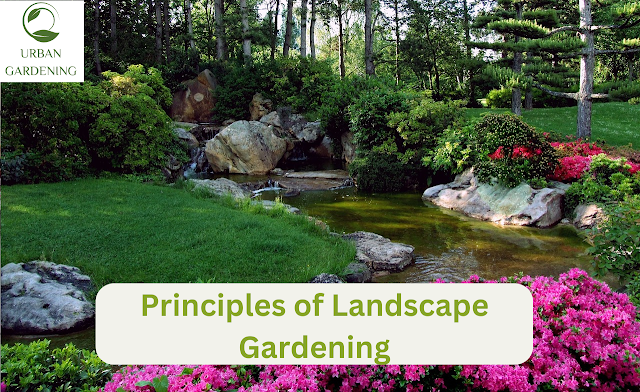6 Principles of Landscape Gardening
Let's delve into the fundamental concepts and techniques that will help you create stunning and captivating landscapes for your home or property. Whether you're a seasoned gardener looking to enhance your skills or a beginner seeking guidance, we've got you covered with all the essential information you need to know.
Let's embark on this journey of transforming your outdoor space into an enchanting oasis.
What is Landscape Gardening?
Landscape gardening, also known as landscape design or landscape architecture, is the art and practice of planning, arranging, and creating outdoor spaces to enhance their aesthetic appeal and functionality. It involves the strategic combination of natural elements, such as plants, trees, water features, and rocks, with man-made elements, including pathways, patios, and decorative structures. The primary objective of landscape gardening is to create harmonious and visually captivating environments that blend seamlessly with the surrounding architecture and natural surroundings.
Through careful consideration of design principles, such as unity, balance, proportion, and rhythm, landscape gardening seeks to achieve a sense of balance and harmony in the outdoor space. Each element within the landscape is thoughtfully selected and positioned to create a cohesive and pleasing arrangement.
Landscape gardening goes beyond mere beautification; it also takes into account practical aspects, such as the functionality of the space, its intended use, and the local climate and soil conditions. By understanding these factors, landscape designers can make informed decisions about plant selection, hardscaping materials, and layout, ensuring that the landscape remains sustainable and easy to maintain.
This multifaceted discipline requires creativity, knowledge of plants and materials, and a deep understanding of the environment. Landscape gardeners work closely with their clients to understand their preferences and requirements, translating them into tangible designs that breathe life into outdoor spaces. The end result is a well-designed landscape that not only enriches the visual experience but also fosters a connection with nature, creating a haven of beauty and tranquility.
Understanding the Essence of Landscape Gardening
Landscape gardening is not just about planting a few trees and arranging some flowers; it's an art that involves harmonizing nature with architecture. The ultimate goal is to design a space that seamlessly integrates the natural elements and man-made structures, creating a balanced and visually appealing environment. This harmony not only enhances the aesthetics of the space but also fosters a sense of tranquility and relaxation.
Key Principles of Landscape Gardening
1. Unity and Harmony
In landscape gardening, unity refers to the cohesive connection between various elements within the design. It involves the strategic arrangement of plants, hardscapes, and other features to create a sense of completeness. Harmony, on the other hand, revolves around the compatibility of these elements, ensuring that they complement each other without clashing.
2. Balance
Balance is a crucial principle in landscape gardening. It aims to distribute visual weight evenly across the space, avoiding any feelings of lopsidedness. There are two types of balance: symmetrical, where elements are mirrored on either side, and asymmetrical, where different elements with similar visual weight are combined to achieve equilibrium.
3. Proportion and Scale
Proper proportion and scale are vital to create a visually pleasing landscape. Oversized elements can overpower the design, while undersized ones may not make an impact. Understanding how different elements relate to one another in terms of size and scale will help you achieve a harmonious arrangement.
4. Rhythm and Repetition
Introducing rhythm and repetition in your landscape design adds a sense of movement and continuity. Repeating patterns of plants or hardscape elements can lead the viewer's eye through the space, enhancing the overall visual experience.
5. Focal Points
Focal points serve as the center of attention in a landscape design. They are carefully chosen elements that draw the viewer's gaze and create a sense of interest. Popular focal points include water features, sculptures, and specimen plants.
6. Simplicity
Sometimes, less is more. A landscape design that embraces simplicity can be just as impactful as a complex one. Simplicity in design allows individual elements to shine and prevents the space from appearing cluttered.
Implementing the Principles: Step-by-Step Guide
Step 1: Site Analysis
Before diving into your landscape project, conduct a thorough site analysis. Evaluate the soil type, drainage, sunlight exposure, and existing vegetation. Understanding these factors will help you make informed decisions during the design process.
Step 2: Conceptual Design
Create a rough sketch or use a digital tool to draft a conceptual design for your landscape. Experiment with different layouts, considering the principles we discussed earlier. This is the stage to explore various gardening ideas and possibilities.
Step 3: Hardscaping and Softscaping
Incorporate both hardscape and softscape elements into your design. Hardscape features, such as pathways, patios, and retaining walls, provide structure and organization to the landscape. Softscape elements include plants, trees, and shrubs that add color, texture, and life to the space.
Step 4: Plant Selection
Carefully choose plants that are well-suited to your local climate and soil conditions. Consider their growth habits, seasonal changes, and maintenance requirements. Group plants with similar needs together to ensure they thrive and complement each other.
Step 5: Maintenance Plan
A beautiful landscape requires ongoing care and maintenance. Develop a maintenance plan that outlines tasks such as watering, pruning, fertilizing, and pest control. Regular upkeep will ensure your landscape retains its beauty over time.
Conclusion
You are now equipped with the essential principles of landscape gardening to create a remarkable outdoor space. By implementing unity, balance, proportion, rhythm, and other design concepts, you can craft a landscape that stands out from the rest. Remember to conduct a site analysis, develop a solid plan, and choose plants wisely to ensure a successful and long-lasting landscape project. Enjoy the process, and may your garden flourish with beauty and charm!
Read Next Blog:




Comments
Post a Comment